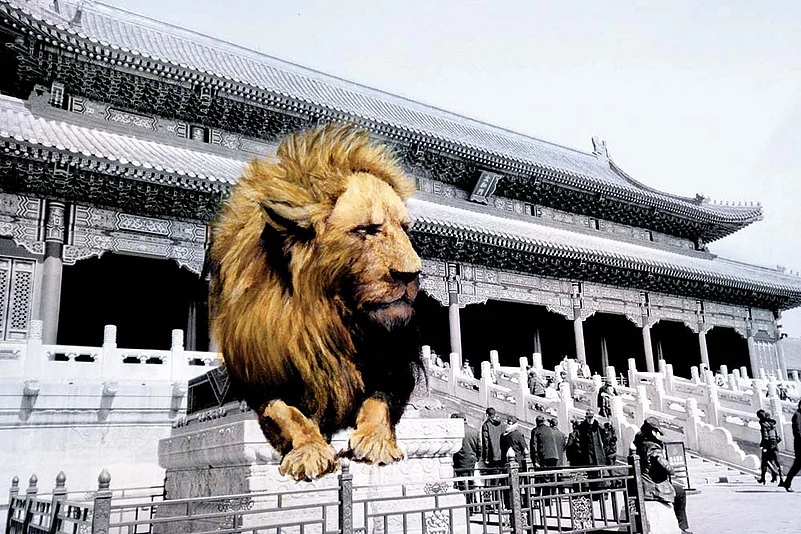Don’t just treat the symptom, the good doctors say—look at the underlying cause. Can that piece of wisdom be applied in the dismal art of diplomacy in times of near-war? That smell of cordite hanging over the crisp air of Pangong Tso is just the surface effect, whoever may have fired the shots. So what triggers it? Why has the newly-minted Union territory of Ladakh suddenly become a mini-theatre for confrontation—complete with body bags, most recently of Subedar Nyima Tenzin, from India’s covert Tibetan force SSF, a sight as filled with poignancy as with high symbolism. As we contemplate the chances of an accidental (or deliberate) war, we must look at the inflammable elements that make up the powder keg.
There are clearly novel elements in the mix now: the Tibet card, for one. If war is diplomacy by other means, peace too carries arrows in its quiver. China is super sensitive about Tibet and India has always maintained a careful balance on that front. On the one hand, it hosts the revered Tibetan spiritual leader, the Dalai Lama, in Dharamshala, headquarters of the Tibetan government in exile. But in deference to China, India does not allow any political or anti-China activities on Indian soil. No Indian minister can meet with the Dalai Lama. This is a provision that can change. Activating the Tibet card will infuriate China, and some signs of that are already in the air: the deployment of SSF at the LAC, and BJP general secretary Ram Madhav’s attendance at Nyima Tenzin’s funeral.
ALSO READ: 1962 Redux?
Simultaneously, there’s also talk of the ‘Taiwan card’. If anything, any move on the controversial Cross-Strait Relation by New Delhi—China does not recognise Taiwan as a separate entity—will sting Beijing harder than even Tibet. India can upgrade relations with Taiwan, encouraging business ties and people-to-people contacts. Taiwan has long wanted to invest in India. While China may not bother about business ties, a visit to the island by a senior official or even a junior minister can show China that India can rock the boat too. As of now, the old caution and calibration is being maintained, but just the fact that these ideas are on the table shows how much the static chessboard is now roiled with tension.
Managing relations with a rising, assertive China is one of India’s major foreign policy challenges this century. Beijing likes to see itself as the headquarters of a world power that will own the future, and India’s own stated ambitions are not exactly modest either—that does not make it an easy tango. The political, economic and military strands of this complex relationship run deep into the soil on either side, and horizontally cover a dynamic field outside: in the neighbourhood and the wider Asian theatre. China’s grand extra-territorial grid, the Belt and Road Initiative, is part of the story; so are the ripples caused by India’s moves on Kashmir’s legal status; also, its pro-US foreign policy tilt in recent decades.
ALSO READ: Do Hold The Horses
All that has led up to the showdown in Ladakh. Recent months have seen a high level of troop engagement, with both sides jockeying for strategic advantage at several points along the Line of Actual Control (LAC). Emotions are running high, and words of war (and peace) are being exchanged urgently from both sides: belligerence and diplomacy, both are proceeding apace. The foreign ministers are meeting, and soldiers are staring each other down on the border—all at once. Neither country may want to take that extreme step, but even an accidental fire by one side could have consequences that can’t be easily controlled.
Trouble is, the rules of engagement with China have changed, with no guarantee that peace and tranquillity can be maintained. The 3,488-km-long border is largely unmarked and until a boundary agreement is reached and maps exchanged, both sides will stick to their perception of the LAC. This border dispute is both symptom and cause—there are regions contiguous to Tibet within India, culturally an extension of the Tibetan sphere, that China claims it ought to have rights over. Beijing has sorted out the border issues with all other neighbours, save India and Bhutan. This long line along the Himalayas lingers as a source of resentment, and also as a lever China can crank up any time it wishes.
As the two Asian giants stand inches away from a potential war, the spotlight is on India’s foreign policy under Prime Minister Narendra Modi. Questions are being asked about whether New Delhi misread China and its leader President Xi Jinping. It can’t have not known that it was a difficult, pingpong love that India was trying to pursue. Modi had shared a swing with Xi on the Sabarmati riverfront in 2014, and visited China twice in the next two years before the June-August 2017 faceoff at Doklam; one more visit, for a BRICS session, followed right after. Modi and Xi then met on the banks of the Yangtse a year later—the ‘Wuhan spirit’ was touted as a resetting of ties. Another show of bonhomie followed at Mahabalipuram last year. Obviously, these rounds of personal tête-à-tête have yielded little dividends.
Ironically, Modi is being accused of blind trust in the Communist Party of China’s leadership: the same charge the BJP regularly heaps on its pet hate, Nehru, for the 1962 debacle. His frank outreach to China presents a paradox, because critics trace China’s current muscle-flexing directly to a contrary strand in New Delhi’s foreign policy: its increasingly close ties with the US, inaugurated in the ’90s by P.V. Narasimha Rao, and adhered to with equal passion by the UPA and NDA-II. This is what has brought the extra needle into Sino-Indian relations.

Defence minister Rajnath Singh at a meeting with his Chinese counterpart General Wei Fenghe in Moscow on September 4.
“The Chinese action in Ladakh is a rude and robust reminder to India of its geography, that it shares an undefined border with China. So tangoing with the US on the Indo-Pacific will not enhance India’s security,” says Talmiz Ahmad, former ambassador and someone who tracks India’s foreign policy closely. He believes China is concerned about India’s close cooperation with the US on the Indo-Pacific and the revival in 2017 of the Quad—the quadrilateral grouping of US, Japan, Australia and India that’s essentially aimed at containing China, and is naturally seen as a strategic threat by it. The Quad is scheduled to meet in Delhi later this month.
According to Ahmad, securing India’s border with China should be of primary concern to Delhi. The South China Sea may be pivotal to US strategic interests, but not India’s, he says. So being party to provoking China on the Indo-Pacific poses much higher risks for India that Washington does not necessarily share. Has India then drifted too far from its foreign policy autonomy for its own good?
“That is a false premise,” says former diplomat P.S. Raghavan, who chairs the National Security Advisory Board (NSAB). “Ever since the 2005 civil nuclear deal, there has been a paradigm shift in ties between the two democracies. India-US ties are a given, China does not need to react to it now, after nearly a decade.” Raghavan reads China’s new aggression as part of a wider behaviour on display across Asia, not something confined to Ladakh—he cites the sabre-rattling over the South China Sea, with Japan, Taiwan and Vietnam. In his view, it has more to do with its new style of aggressive engagement with the world, what’s now called ‘wolf warrior diplomacy’. “The hectoring tone foreign minister Wang Yi is using to lecture the world is making people recoil. According to reports, this was clearly evident during his recent swing through Europe,” Raghavan says.
This introduces another dynamic into the equation. With India seen as firmly in the US ‘camp’, China aims to send a clear message across the region that it’s the Big Daddy, the pre-eminent power of Asia. This is not necessarily ideal for New Delhi, as Washington would do little beyond issuing statements. The flip side is that the Chinese threat could push India even closer to the US—today it’s a defence partner, but if push comes to shove it could well become an ally, and that would further invite the portraiture of being a client state, and more aggression…a vicious cycle wrought by perceptions.
Not all of that is warranted, as a realistic appraisal of enlightened self-interest has always guided New Delhi. That’s partly what spurs New Delhi’s continued opposition to President Xi’s pet Belt and Road Initiative as well as the Maritime Silk Route plan, which has left China disappointed. It’s true that Beijing had tried its utmost to get India onboard. The $62 billion China-Pakistan Economic Corridor, which runs through PoK, which India claims as its own, had turned off New Delhi, as it impinged on issues of India’s sovereignty.
At another level, China itself is in transformation. “The China of Xi Jinping is very different from the China of the past,” says Ashok Kantha, former Indian ambassador to Beijing. “It’s an altogether different ball game now.” Indeed, the 19th congress of the Communist Party of China in 2017 was in a way a coming-out party for China. The country had arrived on the world stage: its ultimate aim was not just Asian hegemony, but to challenge the US itself. It was at this event that Xi elevated himself to a status that hitherto only Mao Zedong has seen, after which measures were initiated to ease the way for him remaining president for life. Xi now spoke of exporting the Chinese way of socialism to the world. After Deng Xiaoping’s opening up in 1978, when Chinese were told to put their heads down and concentrate on development, Beijing has crossed that threshold, and is today the number two economy in the world. The time to assert its dominance has arrived.
And what about India? Non-alignment was the hallmark of Nehru’s foreign policy. It suited the world at that time, with newly liberated colonies forging a new solidarity, staying aloof from the Cold War camps led by the US and the former Soviet Union, and not getting involved in their relentless proxy wars across Asia, Africa and Latin America. Over the years, non-alignment lost much of the sheen of its glory days—though NAM still exists as a body, it’s moribund. Is it dead in spirit too?
Well, India has never abandoned the right to make its sovereign choices. Despite proximity with the US, it still accords a lot of value to its old partnership with Russia—nor has it let Washington’s caveats circumscribe its dealing with Iran. And Modi cannot at least be faulted for not trying with China. Under his regime, the principle of non-alignment still operates, with a few simple tweaks to fit today’s situation, and of course delinked from the Nehruvian nomenclature. Strategic autonomy and strategic choices are the new buzzwords. Like every other nation, India will do what is best for its national interest. Foreign minister S. Jaishankar has publicly said several times in different forums that “non-alignment is an old concept today, but India will never be a part of an alliance system”. And again: “We were never part of an alliance system and we will never be.”
So while New Delhi dallies with the US and its allies in Quad, it’s also a member of the Shanghai Cooperation Organisation, the Eurasian grouping where China and Russia call the shots. Russia, India and China also partner in RIC. India’s ties with the EU and ASEAN are excellent. There was also the BRICS initiative, even if at present it seems likely to belie the enthusiasm with which it began. India has great ties with both Israel and the Gulf kingdoms. And Rajnath Singh’s stopover in Tehran last week for talks with his counterpart was a clear attempt to ease the strains brought on by US sanctions. As it is, China’s overtures to Iran, with a $400 billion deal spread over a 25-year period, is causing major consternation across the world—an Indian affirmation of old ties with Iran comes not a day too late. Forging links with sundry countries on issues of shared interests is the only way forward in a fast-changing world with multiple interests.
“India has to maximise its advantages and make the best of the current flux, being overcautious and timid will not help,” says Kantha, now director of the Institute of China Studies. “India will have to redefine its China strategy and rework policy to fit the changed circumstances. There are no easy answers, nor a readymade playbook, we have to learn as we go along.” Self-interest demands that, given the asymmetry in economic and defence capabilities, India has to make use of “external balancing factors,” Kantha says—that includes loose alliances with the US and other powers with similar concerns about the rise of a belligerent China. Again, whether the Modi government will bring Tibet and Taiwan into the equation is hard to say. But it’s surely not business as usual.


























